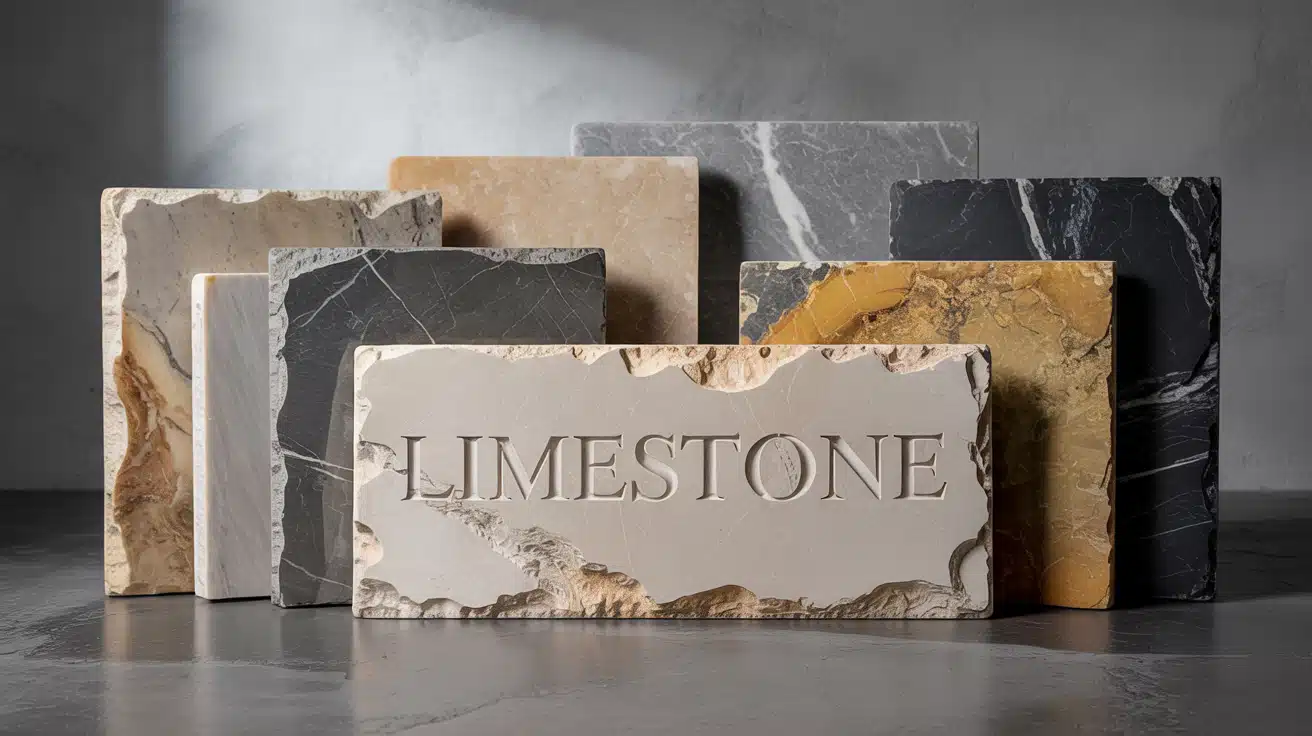From ancient seas to modern countertops, I’m fascinated by how limestone has stood the test of time.
As a sedimentary rock formed over millions of years from the compressed remains of marine organisms, limestone brings geological history right into our homes.
I’ve found that limestone isn’t just practical, its color palette offers incredible design possibilities. Whether you’re drawn to classic beige, refined gray-blue, warm yellow-brown, or dramatic black and white varieties, each shade tells a unique story.
In this guide, I’ll walk you through the color spectrum of limestone, explain the science behind these hues, and share exactly how to use each shade to transform your space.
Understanding the color properties of limestone will help you make more informed design choices while appreciating this versatile stone’s rich heritage.
What Is Limestone, and Why Should Its Colors Catch Your Eye?
From ancient seas to modern countertops, let’s break down this fascinating rock and why its color palette deserves your attention!
Limestone is a sedimentary rock primarily composed of calcium carbonate, formed over millions of years from the compression of marine organisms like shells, coral, and algae.
This natural stone has been used in construction since ancient times, from the Egyptian pyramids to modern home design.
But limestone isn’t just a practical building material; its varied color palette offers unique visual possibilities that can flip any space. Understanding limestone’s color properties helps you make better design choices and appreciate the rich geological history behind this versatile stone.
Limestone’s Color Spectrum: More Exciting Than You Think!
Is Beige the Only Color? Spoiler: It’s Just the Beginning!
When most people think of limestone, they picture classic beige stone. This neutral shade comes from high calcium carbonate with minimal impurities.
- Creates a timeless look complementing virtually any design style
- Warm undertones range from soft cream to sandy tan
- Works in both modern and traditional settings
But limiting yourself to beige limestone is like only seeing one star in a galaxy of possibilities!
What About Gray and Blue? The Sleek, Cultured Vibes
Gray and blue limestone varieties offer cooler tones that bring sophistication and tranquility.
Gray hues originate from clay and silt deposits that are mixed with calcium carbonate. Blue limestone contains manganese and iron compounds, creating distinctive cool tones.
- Gray ranges from light silvery to deep charcoal
- Blue typically presents as subtle blue-gray
- Pairs beautifully with contemporary styles and metals.
A kitchen backsplash made of blue-gray limestone creates a striking contrast against white cabinets, exuding understated elegance.
Can Limestone Be Yellow or Brown? Absolutely!
Yellow and brown limestone bring warmth and earthiness. These colors develop from iron oxide during formation.
The concentration determines color intensity; higher amounts create deeper amber tones, while lower concentrations yield honey shades.
- Yellow offers sunny tones that brighten spaces
- Brown provides rich, earthy visual grounding
- Often feature beautiful veining and fossils.
A yellow limestone fireplace becomes a cozy focal point, while brown limestone flooring creates a natural foundation for high-traffic areas.
White and Black: High-Impact Contrast
At opposite ends of the spectrum lie white and black varieties for bold design statements.
Pure white limestone contains minimal impurities and high calcite concentrations. Black limestone gets its color from bituminous material or organic matter.
- White reflects light, making spaces feel larger
- Black creates dramatic focal points
- Both provide excellent contrast opportunities
White countertops in a dark kitchen provide breathtaking contrast, while black limestone flooring makes an unforgettable entrance statement.
What’s the Secret Behind Limestone’s Amazing Colors?
Mineral Magic: The Chemistry of Limestone Hues
Limestone’s color relates directly to its mineral composition. While calcium carbonate forms the base, additional minerals create the rainbow of colors.
- Iron creates yellows, oranges, reds, and browns
- Manganese contributes purples and blues
- Carbon materials create gray and black tones
- Clay minerals add green shades
- Pure calcite results in white limestone
These minerals tell the geological story of where the stone formed—like a time capsule in your home!
Quarry Origins: Location Matters
Limestone’s color is influenced by its geographical origin, with each quarry producing unique characteristics.
French limestone features honey tones with fossilized patterns. Italian limestone offers consistent whites and grays. American limestone from Indiana is known for buff and gray, while Texas limestone has warmer golden hues.
- Mediterranean limestone tends toward warmer tones
- Northern European limestone features cooler grays
- Tropical limestone contains vivid coloration and fossils
This variation means your limestone carries its own unique backstory!
The Living Stone: How Weather Alters Limestone
Unlike some stones, limestone evolves over time. This patina development adds character and charm.
Over time, limestone may:
- Develop a weathered patina that softens its appearance
- Show subtle color shifts as surface minerals oxidize
- Form a protective surface layer improving durability
Many designers prize this natural aging process. Interior limestone shows minimal changes compared to exterior applications.
Modern sealants help control weathering while maintaining character.
Where Should You Use Each Limestone Color?
1. Light Colors: Perfect for Airy Spaces!
Light limestone, from cream to soft gray, excels in spaces where you want an open feeling.
- Flooring in living areas (makes smaller spaces feel larger!)
- Bathroom wall cladding for spa-like atmosphere
- Countertops that complement without overwhelming
Light limestone’s neutral palette creates a foundation for evolving design schemes with subtle texture that adds interest.
In Mediterranean designs, light limestone with white walls creates a coastal feel that’s sophisticated and relaxing.
2. Dark Varieties: Drama That Demands Attention!
Dark limestone brings weight and drama, creating striking focal points.
- Fireplace surrounds that command attention
- Feature walls with architectural interest
- Flooring in large spaces needing dramatic presence
Dark gray or black limestone paired with brass or gold creates luxury in bathrooms or entryways. The contrast defines zones in open layouts.
A charcoal limestone kitchen island surrounded by lighter cabinetry becomes the heart of the space.
3. Yellow and Brown: Outdoor Beauty!
Warm yellow and brown limestone varieties excel in outdoor applications.
- Garden pathways that blend with the surroundings
- Patio flooring that hides dirt and wear
- Pool surrounds that stay cool underfoot
These earthy tones complement plantings and wooden outdoor furniture, creating cohesive spaces.
Yellow limestone pavers bordered by greenery create timeless garden paths.
4. White: Minimalist Intricacy!
White limestone’s clean appearance makes it ideal for minimalist designs.
- Modern wall cladding
- Substantial floating shelves
- Sculptural bathroom elements
White limestone adds subtle texture to spaces that might otherwise feel stark.
A white limestone accent wall creates a serene focal point, while bathroom tiles bring spa-like luxury.
5. Black: Make a Statement!
For spaces demanding attention, black limestone delivers dramatic impact with natural elegance.
- Kitchen countertops that handle heavy use
- Statement entryway flooring
- Striking bathroom vanities
Black limestone pairs beautifully with lighter woods, creating balanced contrast.
Subtle texture variations add depth that changes with lighting throughout the day.
How to Choose Your Perfect Limestone Color
Create the Right Mood
The limestone color you choose should reflect the feeling you want:
- Light beige and cream create calm, airy environments
- Gray and blue offer sophisticated serenity
- Yellow and brown bring warmth and comfort
- White delivers crisp minimalism
- Black provides dramatic luxury
Consider how the space will be used. A home office might benefit from cool gray limestone, while a family room feels welcoming with warmer honey tones.
Think about lifestyle too, are you creating a showcase home or comfortable everyday space? The answer guides your color selection.
Maintenance Matters
Practical factors should influence your choice:
- Lighter colors show dirt but hide dust
- Darker colors show dust but conceal stains
- Mid-tone varieties offer the best balance for high-traffic areas
Your cleaning tolerance should guide selection:
- White countertops require prompt attention to spills
- Beige flooring in entryways shows tracking
- Black shower surrounds reveal water spots
Proper sealing helps mitigate these issues, but choosing a color matching your expectations creates greater satisfaction.
Coordinate with Your Décor
Integrating limestone requires thoughtful coordination:
- Consider undertones, warm beiges for warm interiors, cool grays for cooler schemes
- Use veining that incorporates your accent colors
- Create contrast through careful color selection
Remember, texture plays a crucial role too. Honed limestone differs from polished varieties even in identical colors.
Welcome limestone’s natural variations as character rather than seeking perfectly uniform pieces.
The right limestone color promotes your design with natural texture and timeless appeal synthetic materials simply can’t match!
When you understand the full spectrum of limestone colors and their applications, you can make choices that blend beauty, practicality, and personal expression in your home design.
Final Thoughts
Scouring limestone’s color spectrum reveals how this ancient material brings both practical benefits and visual richness to our spaces. From beige classics to dramatic black varieties, each shade offers distinct design possibilities rooted in geological history.
The stunning diversity of limestone colors, created through mineral deposits, geographical origins, and natural aging, provides options for every design vision.
Whether creating airy, cultured spaces with light tones or bold, dramatic statements with darker varieties, limestone’s natural variations add character impossible to replicate artificially.
Selecting the perfect limestone color involves balancing your desired mood, maintenance preferences, and existing décor. By understanding these factors, you’ll find a limestone variety that improves your space while expressing your personal style.
This timeless material continues to captivate with its natural beauty and remarkable color range.













